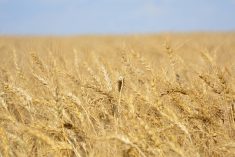A decline in Canadian acreage and possible production problems in Ontario will leave navy bean supplies tight for the 2008-09 crop year.
“We’re going to have barely enough to go around,” said Ivan Sabourin, president of Roy Legumex Inc., a large Manitoba bean processor and exporter.
Agriculture Canada projects a four percent decline in dry bean acreage and a 10 percent drop in dry white (navy bean) plantings in 2008.
Sabourin doesn’t buy those numbers. The department has pegged Manitoba’s bean crop at 170,000 acres, but he believes it will be closer to 150,000 acres when the Manitoba Crop Insurance numbers come out in mid-July.
Read Also

Strong canola exports expected to tighten supply
Canola exports will end up the third strongest in the past 10 years, according to recent Canadian Grain Commission weekly export data.
FarmLink Marketing Solutions also finds the government’s numbers suspect. A week before Agriculture Canada’s July 2 Pulse and Special Crops Outlook, the firm was predicting 2008 bean acres would be down by more than 20 percent nation-wide from last year.
“It’s a bit of a surprise for us,” said FarmLink analyst Darren Frank.
However, beans are such a small crop that it’s largely immaterial whether it’s the 363,000 acres Agriculture Canada has forecasted or the 300,000 acres FarmLink was originally calling for.
“What we’re watching right now is the yields,” Frank said.
Manitoba’s bean crop got off to a poor start with cool conditions putting it 10 days to two weeks behind normal development. However, two weeks of hot weather has allowed the crop to catch up and now it looks good.
Behind the times
The same can’t be said for Ontario’s crop, which is severely delayed due to a wetter than normal spring. Much of the crop has yet to be planted.
Frank said any production setback could send navy beans past the rarely broken 50 cents per pound threshold.
Sabourin wasn’t willing to attach a number to it, but he agreed any supply crunch would create upward price pressure for navies.
“If there is a substantial shortfall in Ontario along with Michigan on the white bean complex, it could be very interesting, for sure. Who knows what the top is?”
Frank said new crop navy bean contracts are in the 40 to 42 cents per lb. range, which is a three to five cent premium over pintos and blacks.
“Unless we pull off some pretty astonishingly good yields for the navies, they’re probably going to stay at a premium all year to the other two, which in years past hasn’t been the case.”
Sabourin thinks blacks are now competitive with navy beans and the market outlook is promising because China, which has been undercutting Canada in markets such as Venezuela and Cuba, is facing a vastly reduced black bean crop.
He believes the Chinese crop could be cut in half from last year because black bean prices rose in that country only after planting was completed.
“If the decline is as substantial as we think it is, we might recapture, for the first time in a while, some of these overseas markets that we’ve lost to them.”
Pintos may follow
Pinto prices have been lagging behind the other two main types of beans grown in Canada, but Sabourin wouldn’t be surprised to see them rise.
The U.S. Department of Agriculture expects an eight percent decline in bean acreage, including a 13 percent decline in North Dakota, the largest bean growing state. Sabourin believes most of North Dakota’s decrease will be in pintos.
“We’re calling for a pretty dramatic decrease in pinto bean (production),” he said. “However, there is a carryover that we have to eat through before we start pressuring prices.”
Frank’s big lingering concern is all the rain that has fallen on beans in Manitoba’s Red River Valley.
“It seems like every cloud that’s going by we’re getting hit with a quarter to half an inch (six to 13 millimetres) of rain.”
He remembers what happened to the 2004-05 crop when the Red River Valley received a late summer dump of 127 mm of rain. Growers planted 395,000 acres of beans that year and harvested 303,000 acres.
“A two or three inch (51 to 76 mm) heavy rain now in the valley would do some serious damage to the beans because the ground is so saturated today.”
Sabourin said the crop had been one heavy rain away from a disaster, but the recent spell of hot weather has absorbed most of the excess moisture and removed the threat.
“We were lucky that we dodged a bullet there.”
Agriculture Canada expects 20,000 tonnes of dry bean carryout, identical to last year. FarmLink predicts 9,000 tonnes. Either way, ending stocks will be well below the 10 year average of 32,000 tonnes.
That, combined with the anticipated 15 percent decline in U.S. bean production, should increase prices.
In its July 2 outlook, Agriculture Canada said the average price over all types and grades of beans is forecast to increase because of the lower North American supply.
Frank said while most farmers have already contracted their first 800 to 1,000 pounds per acre of production, the strategy this year should be to keep some production on the farm if possible.

















